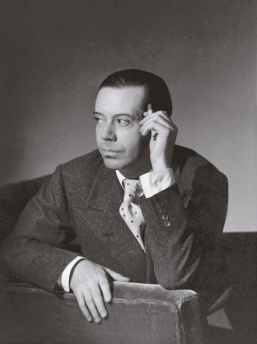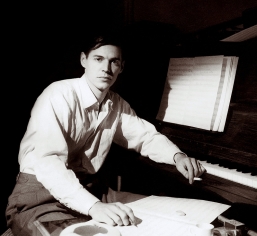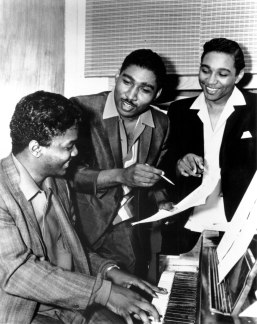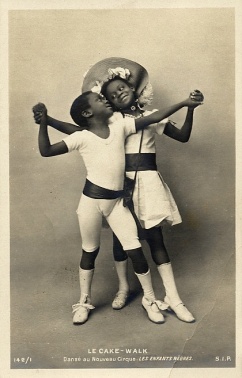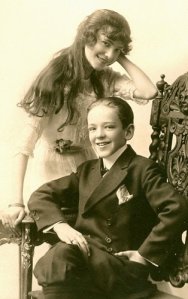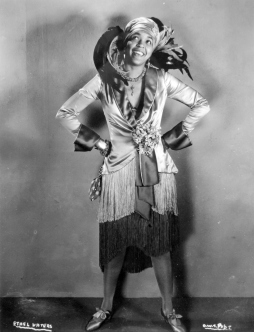Puttin’ On the Ritz
_________________________
Puttin’ On the Ritz (Irving Berlin) — first published on 2 December 1929[1]
 The original lyric describes poor Harlemites dressing up elegantly, parading down Lenox Avenue and otherwise “puttin’ on the Ritz”. The idiom means behaving in a luxurious, extravagant manner, especially while making ostentatious display of one’s wealth. The term Ritz refers to the luxury hotel chain.
The original lyric describes poor Harlemites dressing up elegantly, parading down Lenox Avenue and otherwise “puttin’ on the Ritz”. The idiom means behaving in a luxurious, extravagant manner, especially while making ostentatious display of one’s wealth. The term Ritz refers to the luxury hotel chain.
The lyric gently pokes fun at a certain set of people who, in efforts to look well-off, spend more than they can afford, even their last two bits (25 cents), and suggests that watching them behave in this manner might be an amusing form of entertainment.
Some lines in the lyric might have been perceived as racially offensive. Consider, for example:
Spangled gowns upon a bevy
Of high browns from down the levee,
All misfits,
Puttin’ on the Ritz
A revised lyric version was introduced by Fred Astaire in the 1946 film Blue Skies, with Berlin having rewritten lines containing words that identified those targeted in jest by their skin color or by presumed origins in the Deep South (high browns, Lulu Belle, from down the levee), and with the locale of their revels having been changed from Lenox Avenue in Harlem to Park Avenue. The two lyric versions may be found in the book The Complete Lyrics of Irving Berlin, edited by Robert Kimball and Linda Emmet (2001), on p. 262 and p. 263.
A couple more lines from the original lyric, with the phrase “That’s where” referring to Lenox Avenue in Harlem:
That’s where each and ev’ry Lulu Belle goes
Ev’ry Thursday evening with her swell beaus
Rubbing elbows
The fact that it is specifically “Ev’ry Thursday evening,” and not on Friday or Saturday nights, that the spectacle can be viewed is significant. The “Talk” section of the Wikipedia page on the song, without providing sources, claims that “Lulu-Belle” was a “generic nickname for a black maid” and that “Thursday evening, of course, was the traditional maids’ night off.”[2] Similar statements can be found at numerous other locations on the web. Some articles and books indicate that Thursday night was a traditional night off for domestic workers, especially live-in or sleep-in domestic workers, rather than for maids only.[3]
Among the earliest of the numerous 1930 recordings of “Puttin’ on the Ritz” were those by Leo Reisman and his Orchestra (vocal: Lew Conrad), Jan Garber and his Orchestra (v. Maxwell Covert), Harry Richman with Earl Burtnett’s Biltmore Hotel Orchestra, Earl Burtnett and His Los Angeles Biltmore Hotel Orchestra (v. Paul Gibbons), The Clevelanders, and Fred Astaire. Harry Richman performed the song in the 1930 film Puttin’ on the Ritz, which premiered on 19 February 1930. Clark Gable sang and danced to the song in the 1939 film Idiot’s Delight. Theater audiences were amazed to see romantic leading man Gable in a lighthearted dance routine with straw hat and cane, and backed by a chorus line.
_____________________________
Leo Reisman and his Orchestra, vocal: Lew Conrad — recorded 20 January 1930 and issued in April 1930 on the 78 rpm single Victor 22306, b/w “Singing a Vagabond Song” (B-side recorded by Nat Shilkret and the Victor Orchestra) — SecondHandSongs.com indicates that this was the first recording of the song.
.
Jan Garber and his Orchestra, vocal: Maxwell Covert — recorded on 24 January 1930; issued on Columbia 2115-D, c/w “When a Woman Loves a Man” — The Discography of American Historical Recordings indicates that two different 24 January 1930 takes (takes 2 and 3) of “Puttin’ on the Ritz” were mastered, assigned the same Columbia matrix number W149912, and issued with the same catalog number 2115-D.[4]
audio file, VBR MP3 (6.1 MB), from the page Puttin’ on the Ritz (Dandose Tono), at archive.org:
.
From Wikipedia:
Harry Richman (10 August 1895–3 November 1972) was an American entertainer. He was a singer, actor, dancer, comedian, pianist, songwriter, bandleader, and night club performer, at his most popular in the 1920s and 1930s.
Richman was born as Harold Reichman in Cincinnati, Ohio. He changed his name to “Harry Richman” at age 18, by which time he was already a professional entertainer in vaudeville. He worked as a piano accompanist to such stars as Mae West and Nora Bayes. With Bayes’ act he made his Broadway debut in 1922. He appeared in several editions of the George White’s Scandals in the 1920s to acclaim. He appeared in the 1931 Ziegfeld Follies.
He made his feature movie debut in Hollywood in 1930 with the film Puttin’ on the Ritz, featuring the Irving Berlin song of the same title, which gave Richman a hit phonograph record that year.
Harry Richman with Earl Burtnett’s Biltmore Hotel Orchestra — recorded on 30 January 1930; issued on Brunswick 4677, c/w “There’s a Danger in Your Eyes Cherie!”
.
Harry Richman — in the 1930 film Puttin’ On the Ritz, which premiered on 19 February 1930, with the general release being on 1 March 1930
.
Earl Burtnett and His Los Angeles Biltmore Hotel Orchestra, vocal: Paul Gibbons — recorded on 31 January 1930 (one day after the Harry Richman recording); issued on Brunswick 4679, c/w “With You” (Irving Berlin)
.
Fred Astaire — recorded in London on 26 March 1930; issued in May 1930 on the single (UK) Columbia DB 96, b/w “Crazy Feet”
.
The Clevelanders — Imperial (UK), 1930
.
Phil Spiltany Orchestra (as “Hotel Pennsylvania Music”), vocal: Danford Sisters — recorded on 19 February 1930; issued on the 78 rpm single Harmony 1110-H, b/w “With You”
The second recording of “Puttin’ On the Ritz” in this video (beginning at 2:57), by Carl Webster’s Yale Collegians, is apparently also from 1930.
.
Alfredo and his Band, vocal: Eddie Grossbart — issued in 1930 on the 78 rpm single Edison Bell Radio 1375, b/w “On the Sunny Side of the Street”
.
.
Clark Gable — Idiot’s Delight (1939)
.
.
Fred Astaire — in the film Blue Skies (1946)
.Benny Goodman Trio — 1947
.
Taco Ockerse — A “synthpop” disco version by the artist better known as Taco was released as a single in 1982. According to the Wikipedia article on the artist, the single reached #4 on the Billboard Hot 100, #1 on Cashbox, and attained a top 5 position in Canada. The single was also very successful in Europe, topping the pop charts in Sweden and New Zealand, and entering the top 5 in other countries including Norway and Austria.
The original video for the Ockerse recording is notorious for having included dancers in blackface. The following video is from a performance, without blackface, for (if I understand the video provider’s description correctly) the 31 December 1983 New Year’s Eve episode of the German TV show ZDF Silvester-Tanzparty.
.
Jiří Korn — Televarieté 59, 1987; with the Czechoslovak dance group Uno
_______________________________
1. From The Complete Lyrics of Irving Berlin, edited by Robert Kimball and Linda Emmet (2001), p. 262:
Published with two different lyrics. Written in May 1927. First published December 2, 1929, after being registered for copyright as an unpublished song August 24, 1927, and again on July 27, 1928.
2. glossary (from the “Talk” section of the Wikipedia page on the “Puttin’ on the Ritz”):
Lenox Avenue – A main thoroughfare in Harlem.
High browns – A variation of the phrase “high yellow”, referring to those of mixed racial background, usually with the inference that they are putting on airs beyond their social station.
Lulu-Belle – A generic nickname for a black maid.
Thursday evening – Typically, the maid’s night off.
Two bits – a quarter (25 cents)
The source of all but the “Two bits” line of this glossary might have been a 2002 contribution by Debbie Davis to the page on the song at International Lyrics Playground.
According to the Wikipedia page on Lenox Avenue, “In 1987, it was co-named Malcolm X Boulevard, in honor of the slain civil rights leader.“[5][6]
3. At some point, the term “kitchen mechanic” evidently became a common euphemism for “domestic worker,” or perhaps for a certain category of domestic worker, and at the Savoy Ballroom Thursday night became known as “Kitchen Mechanics’ Night.” According to the Autobiography of Malcolm X, chapter 5: Harlemite, pp. 86-88, on his first visit to Harlem while living in Boston, c. 1941 (age 16), Malcolm X attended the Savoy Ballroom on Kitchen Mechanics’ Night.
4. Additionally, two takes (takes 2 and 3) of “When a Woman Loves a Man,” recorded on the same date, and each assigned the matrix number W149913, were issued as the flip sides of the different releases bearing catalog number Columbia 2115-D. It’s not clear whether the take numbers of the B-sides of such releases were the same as the take numbers of the A-sides.









